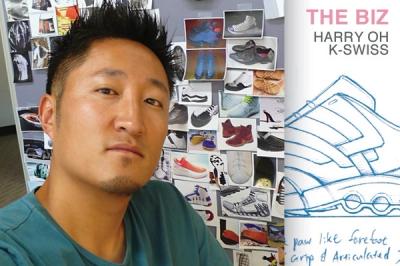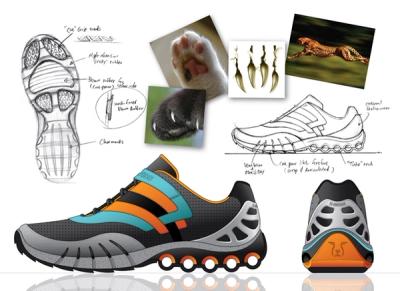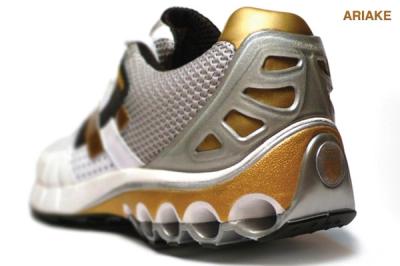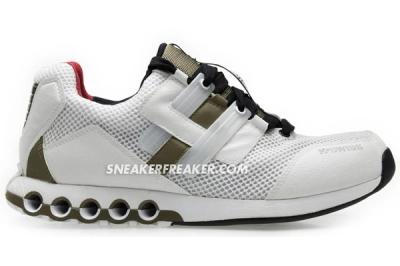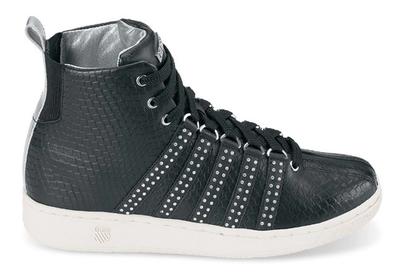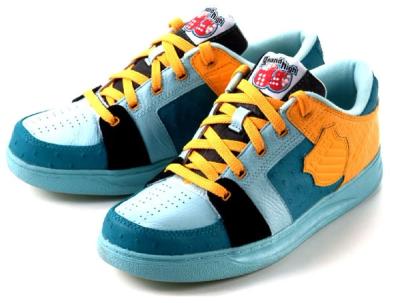The Biz! Harry Oh (K-Swiss)
From humble beginnings working on the floor of his Pop’s shoe store, Harry Oh was determined to get into the biz. Like a sponge, he soaked up every ounce of knowledge and enrolled at the Pasadena Art Centre College of Design, which led to a coveted internship with K-Swiss. Several years later, Harry is now graced with the illustrious title of Senior Designer, meaning he oversees a team of technical tinkers on a mission to take the five-stripes into a whole new era. Remember kids, there is no ‘i’ in team work!
So, Harry, tell us a bit about yourself. Where are you based?
I’m actually based in Westlake Village, California. It’s around 30 miles up north of downtown LA.
Did you always want to be a designer?
Not really. I was always pretty good at drawing and painting. I used to collect kicks, not as madly as other kids but I was always constantly drawing them. I decided to go to college and while there I read some magazine articles that talked about some well-known shoe designers which inspired me as it seemed like they were doing a lot of cool stuff. My dad used to run a shoe store back in high school and I used to help a lot on the weekends, so that got me started in this industry as well.
Where did you study?
I went to Pasadena Art Centre College of Design where I majored in product design. And actually, I was fortunate to take an internship with K-Swiss, which led me to a full time job as soon as I graduated from school.
That sounds like a pretty smooth transition.
I guess so, it worked out for me!
Was the course difficult?
I guess so, it depends if you’re really up for it or not. It’s a pretty intensive program and I had to pull all-nighters. It was something I wanted to do, but it was all fun now when I look back at it.
You’re now a Senior Designer. What exactly does that mean?
Well, all the designers here work as a team, but as Senior Designer, I get to do more of the complicated design tasks. Because I’m in a performance category which involves more technical work, I’m involved in a lot of important decision-making in terms of design and technical drawings.
So do you literally sit down with a blank page and start sketching a shoe from scratch. Or do you spend more time refining existing ideas?
Actually we usually get some sort of direction either from upper management, a category manager or from marketing for each season. That inspires us to go out and do some research and at some point in time after we gather all the information, we do sit down and start with a blank page, which is kind of scary. But that’s where it all starts, with a small sketch.
When does the computer come into it?
I usually start with pencil sketches, which are really loose. I present them to my group to get some feedback and then revise them again. At some point, if you think you have an idea set, we move on to the computer. I use Photoshop and Illustrator to do the renderings of different views, however, it depends on the shoes. From there we make it more presentable, with more details. Then we go through several other meetings and narrow it down and refine it further. And then after that, if we finalise a design we go into the technical drawings. K-Swiss is known as a white casual classic/tennis shoe company, but something we were recently doing was trying to get into serious performance running product like free running for example. There are so many technologies we use, some of which I can’t really go deep into right now because it’s supposed to be released next year. Right now we are going through a trial and error phase to improve the existing cushioning, comfort, traction in all of that area.
What direction is the Free Running project moving in?
The first Ariake shoe had great feedback from the traceurs, who said it had great cushioning traction. But when I actually travelled with some of the traceurs, the feedback I got was that the shoes were not as durable as they would like. So that was the main thing we tried to improve, you know, to make it more durable. But at the same time, I didn’t want this shoe to be too heavy. And we didn’t want to lose any flexibility or the cushioning. So it was tricky, but I think we got it and we’ve given out the sample to the traceurs and gotten more feedback. We improved it again, revised it and we have added some kind of new cushioning system on the heel too, which will be released next year. You’ll see it in more detail.
How many people would be involved at K-Swiss bringing a product from say your original sketch to the shelves? Can you give us an idea of the scope of your team?
We have a product development team including designers and we have developers, (people who work really close with the designer, sometimes like one to one) We pair one designer and one developer, assigned together. And if you go up in management, there are design directors and category managers. So roughly just within our team, there is about 25 people. And I guess in order for our shoes to finally hit the shelves, there’s so many more people involved, like the workers in the factory and all the engineers. I would say hundreds and hundreds of people.
Can you explain the role of the developer? How would you describe their role and how it complements what you do?
When we start a project, even from the beginning, we work together, like coming up with the projects and detailing the brief. When we start sketching, I go back and forth with the developer and they advise us about the technical side of it, as in materials and what can be done and what cannot be done. We then build the shoes, make the sample and because there are so many materials involved in building up one shoe, the developers are the specialists for that. They pick the materials, how big the foam inside should be and what the costing of each component will be. They mainly communicate with the factory to build the shoes. And when we get the samples back they help us out to advise where we could lower the cost, or help with more durable materials. So we’re almost like a family.
At what point does it go from being a two-dimensional drawing to a three-dimensional plan?
You know, when I mention the technical drawing, it’s still the flat piece of paper. We hand it out to our modellers in here and more technical modellers in China. And when we send those out they actually build a crude mock-up model and send it back to us so we can see it in 3D form. The bottom of the shoe is the toughest because they actually have to open the mould, which costs a lot of money and time. So everything we do is before the mould is opened. The modellers create the file and we can take a look at it like that. We have a 3D printer in-house so we actually get to touch something and put the uppers on and make some revisions from there. And when that gets approved, we go ahead and open the mould.
I must admit I’ve never seen a 3D printer. How does that work?
It’s pretty cool. Just think of it as a regular colour printer, but instead of ink, it shoots real plastic particles in a glue. It just builds from the bottom all the way to the top and prints a 3D shoe!
Yeah, alright, I’ve heard of them, I’ve never seen one though. I’d really be intrigued to see what that looks like.
Yeah, it’s a trip!
I think anyone who’s interested in design, whether it’s graphics or industrial design or product design, there’s always an element of never being quite sure whether a design’s finished or not. How do you know when you’ve finished a design? Is it just an instinctive feeling?
I never feel a shoe is finished. I don’t think it’s ever finished because sometimes we just keep making the revision until the last minute, even before production we are still making changes. A good example is when I see something I designed back when I first started at K-Swiss. Back then I thought it was finished but now I see a lot of flaws that I can improve on, so I guess that’s why we need more shoes.
That’s why you’re a Senior Designer now, you’ve actually accumulated some experience.
Yeah, true I guess.
Do you think you’ll always work in footwear, given your skills would presumably translate into other areas of design?
For now, yes, I think so. It’s really attractive. I always like the shoes and I deeply get into it. I mean I appreciate a lot of the time and effort that people put in to build one shoe and I think footwear in general. Besides out of all the design stuff, I think it’s really fast paced in terms of production and the number of rounds of samples we create. That’s another thing I really like about footwear design, you know, you can get to see the shoes like a month later, you actually see the full shoes in your hand, not like in car design. I mean nothing’s wrong with car design, I really like car design. But it takes years and years to get your final product. So I think that’s another cool thing about footwear. I’m going to do be doing it for a while, plus I’m doing some graphics stuff for friends on the side, but my main focus is footwear.
Is there one shoe that you’ve worked on or a project you’ve been a part of that you think is probably your favourite moment at K-Swiss?
Well I had an experience a couple of years ago in China when I went to see some of my samples and make some changes. I went to the factory and I saw the whole assembly line there. They were actually building one of my shoes! That was the first time I got to see my shoes on a production line. And there’s like hundreds and hundreds of people who were building these shoes and you know, I was kind of shocked. ‘Wow, they’re really making my shoes!’ That was an emotional moment for me and I guess it was my proudest moment at the same time. And sometimes when I design a shoe, and I get the samples, when I’m done with them, I give them out to a couple of my good friends and I see them wearing them over and over. It strikes me like ‘oh wow, they really like their shoes’ and that’s another proud moment as a designer.
Because you care so much about the product, and because you’re the designer, are you really conscious of how well a shoe is doing? Do you get really nervous about a new design coming out?
Yeah, in a way I guess so, because when I design my shoes, I put a lot of time into it. I hope that it makes a lot of money for our company. I used to keep track of numbers, but now I’m kind of over that point I guess. It’s always good to hear that my shoes are doing well though.
Yeah, everyone’s got to like that. What advice would you give kids who want to get into the industry? You mentioned you were an intern all those years ago.
Well I guess the first thing is you have to be passionate about what you want to do. I know a lot of kids just like me, you know, who love the shoes, but they have to be committed and passionate about what they want to do and they have to be patient and keep knocking on the door and never give up. We actually tend to work as a team a lot, so you have to be open minded for a lot of stuff and have a good attitude and not piss off anybody ‘cause you never know. Being open minded is a pretty important thing because I tend to absorb. Back in my intern days, I tried to ask a lot of questions and tried to listen carefully to what everybody else said. Be like a sponge, absorb everything you can and then filter through it later on and find your own style.
Yeah, that’s great advice. What sneakers are you wearing right now, Harry?
Ah, let’s see. I’m wearing the new running shoes I designed for next year. It’s a silver-orange colour; it’s going to be cool.
This article appeared in Issue 13 of Sneaker Freaker. Buy it
